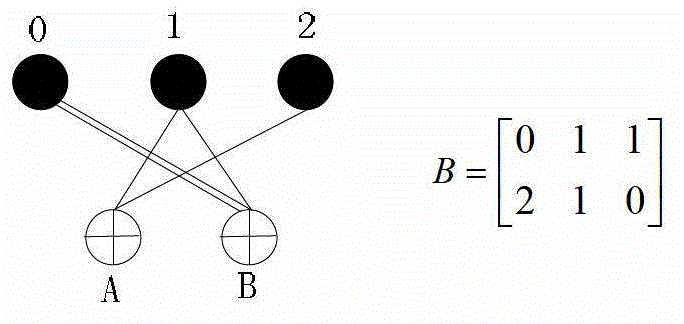Quasi-cyclic low density parity check code (LDPC) construction method and device based on protographs
A technology of an LDPC code and a construction method, which is applied in the field of channel coding and can solve problems such as deteriorating the performance of LDPC codes.
- Summary
- Abstract
- Description
- Claims
- Application Information
AI Technical Summary
Problems solved by technology
Method used
Image
Examples
Embodiment 1
[0049] The algorithm of the present invention is used in the existing AR4A series of original model diagrams with a code rate of 1 / 2, and three groups of code rates are constructed with 1 / 2, and the parameters are (576, 288), (1152, 576), ( 2304, 1152) quasi-cyclic LDPC code. The structure of the original model and the corresponding matrix are as Figure 8 Shown. Figure 8 ● and ○ are variable nodes, It is a check node, where ○ represents the variable node to be punched, and the maximum number of multiple edges of the original model graph is 3. Taking the construction of (576, 288) code as an example, the specific construction process is as follows:
[0050] The first step is to select the original model of the AR4A series with a code rate of 1 / 2, and the corresponding matrix size is 3×5. The protograph represents an LDPC code with a code length of 4 (the 5 columns of nodes in the matrix contain 1 column of punctured nodes, so the effective code length is 4).
[0051] The second...
Embodiment 2
[0067] The algorithm of the present invention is applied to the existing AR4A series of original models with code rates of 2 / 3, 1 / 2, and 1 / 4, among which the AR4A series of original models with code rates of 2 / 3 and 1 / 4 are as follows: Picture 10 , Picture 11 Shown. The length of the information bits of the three groups of quasi-cyclic LDPC codes is 300 bits, and the parameters are (450, 300), (600, 300), (1200, 300). The specific construction process is similar to Embodiment 1. The decoding performance of the constructed codeword is excellent, and the simulation results are as follows Picture 12 Shown.
PUM
 Login to View More
Login to View More Abstract
Description
Claims
Application Information
 Login to View More
Login to View More - R&D
- Intellectual Property
- Life Sciences
- Materials
- Tech Scout
- Unparalleled Data Quality
- Higher Quality Content
- 60% Fewer Hallucinations
Browse by: Latest US Patents, China's latest patents, Technical Efficacy Thesaurus, Application Domain, Technology Topic, Popular Technical Reports.
© 2025 PatSnap. All rights reserved.Legal|Privacy policy|Modern Slavery Act Transparency Statement|Sitemap|About US| Contact US: help@patsnap.com



